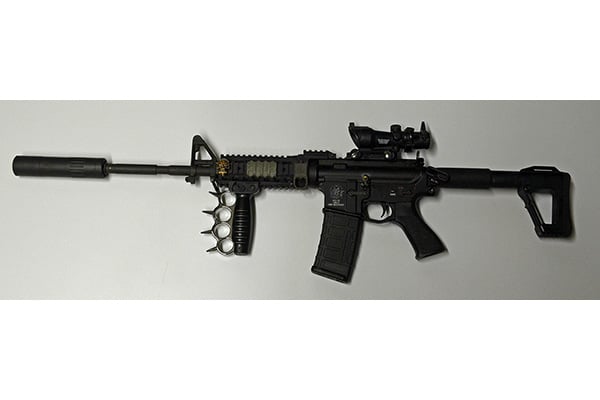
Last Updated on
By Mike Searson
In 2012 the AR15 rifle outpaced the venerable Winchester Model 94 as “America’s Rifle.” The reasons are varied, having served the US Armed Forces for over 50 years is certainly a motivating factor, being extremely user friendly is another and finally the rifle is particularly prone to customization to the point it has been compared to “Legos for Adults.”
With the mere push of two pins, an AR15 can be converted to a rifle of a different caliber with a different barrel length and accept a completely different sighting system. A shooter can go from a short range defensive carbine to a 22 plinker or a long distance varmint hunter in a matter of seconds.
This modularity did not happen overnight and is a result of the US Army’s SOPMOD project to make the M16 service rifle more compatible with mission needs as well as a long time civilian shooter trend to use the rifle in hunting and the competitive shooting sports. These two fields have converged in more ways than one and the end result is that today a shooter can build an AR15 in just about any configuration imaginable.
Butt Stocks
The butt stock is a common part that most shooters change on their rifle. There are two basic configurations for an AR butt stock: fixed or collapsible. Collapsible stocks serve two functions: ease of storage and they provide the shooter an adjustable length of pull.
One of the author’s favorite butt stocks is the ACE M4 SOCOM stock. This is a collapsible stock with multiple sling attachment points and has an all steel stock toe on par with a framing hammer for strength when it comes to battering doors or bad guys. We see a lot of butt stocks and rifles in numerous configurations and the M4 SOCOM is by far the most solid on the planet.
A close second in terms of a solid collapsible stock is the UBR (Utility Battle Rifle) by MagPul. Mostly composed of polymer as opposed to ACE’s all metal stock, the UBR locks solidly into any position for length of pull and it includes its own buffer tube. The stock incorporates a unique storage compartment for incidentals and can be fitted with a metal strike plate for CQB if desired.
When it comes to long distance shooting, the author prefers the MagPul PRS (Precision Rifle Stock) which is adjustable not only for LOP, but height as well which is vital when using telescopic sights.
Pistol Grips
As common a change as the butt stock may be, the pistol grip is probably the first thing to go on any AR as far as a part’s change. There is nothing wrong with the standard issue M16A2 type grip if you like a big plastic finger groove in the middle of your grip, but it may be the easiest part to exchange. While the author has no problem with the stock grip, boxes of “take-offs” spotted in gun shops from Alaska to Florida suggest that the masses think otherwise.
MagPul makes a variety of grips, some which incorporate a storage compartment and these seem easier on the shooter’s hands as they eliminate the A2’s distinctive finger groove. Similar in design are the grips made by Tango Down LLC.
Hogue manufactures a grip similar to the A2 configuration but in their proprietary recoil inhibiting rubber with a better designed finger groove pattern.
Forend
At one time, shooters had limited options for their AR’s forends: triangular or round plastic. In the late 1980s and early 1990s, modular forends emerged that made use of a Picatinny rail. This allowed a shooter to add a myriad of accessories to their rifles in the form of visible white lights, laser aiming devices, infrared pointers, vertical fore grips and the list goes on.
Some rails like those made by Midwest Industries replace the existing hand guards, but most others require removal of the hand guard retention cap and can call for a smaller front sight base as a result.
As versatile as the Picatinny rail is, it can become quite heavy and is being replaced by lighter weight alternatives such as the key mod design. Other companies like MagPul offer polymer hand guards that take accessory rail sections to keep the weight down and allow the quick installation of a flash light or sling mount as opposed to a large section that mostly goes unused.
Barrels
The rifle’s barrel could be treated to a separate article of its own, but we will address it here. Some shooters in recent years have shown a preference for a skinny profile barrel to reduce weight and for a more retro look. The author prefers a heavier barrel or a partially heavy one based on his experience with the M16A2 rifle.
In addition to profile, choices abound with materials: stainless steel vs. chrome moly steel; chrome lined chamber and bore vs. non-chromed; carbon fiber is even an option with a steel liner.
The chamber is important with regard to 5.56 rifles as 223 Remington will chamber in them, but military 5.56 is loaded to higher pressures and may not be safe in a barrel marked 223 without the use of what is known as a Wylde chamber.
Twist rate is critical with certain ammunition types and refers to how many complete revolutions a bullet makes. A 1 in 9” rate means that the bullet makes a complete revolution for every 9” of barrel length. Tighter twist rates are essential for using longer and heavier bullets for extreme distance as they will not stabilize properly with a looser twist rate.
Barrel length can range from 7.5” to 26” with 16”and 20” being the most common. Installation of a sub-16” barrel on a rifle requires a $200 tax stamp and approval from the National Firearms Act (NFA) office of the Bureau of Alcohol, Tobacco, Firearms and Explosives (ATF).
If you do go the SBR (Short Barreled Rifle) route, keep in mind that most silencer companies will not honor the warranty on their silencers or even guarantee them to work on a barrel less than 10.5”.
Calibers
With barrels and interchangeable upper receivers it is possible to chamber at least thirty other cartridges in an AR15. Some conversions are as easy as changing the standard bolt carrier to a 22 rim fire carrier and magazine to shoot cost effective 22 lr through the rifle.
Some calibers such as 300 Blackout require only a replacement barrel as the same bolt carrier and magazine can be used, but others such as 7.62 X39, 9mm, 45 ACP, etc. require a bit more work to make an effective conversion. Sometimes the buffer and action spring in the butt stock require replacement and in nearly every case the bolt face (if not the entire bolt) and magazine need to be changed as well. Pistol calibers typically require an adapter for the magazine well.
With the decreased price of lower receivers in recent years, it often makes more sense to build a dedicated rifle in another caliber as opposed to swapping upper receivers between rifles.
Larger calibers such as 308 Winchester in the pattern more commonly known as the AR10 have about an 80% parts interchangeability rate with the 5.56 version. Complete uppers may be had in much larger calibers such as 50 BMG or 338 Lapua Magnum, but these are most often become single shot rifles.
Sights
The most noticeable change in the past 20 years with regard to the AR platform is the loss of the distinctive “carry handle” which housed the rear sight. The emergence of the flat top upper receiver allows the shooter to choose from a variety of sighting systems from red dots or holographic sights to night vision or long range scopes. The Picatinny mounting system allows for the installation of fixed or pop-up iron sights as primary sights or backups in case the primary optic should fail.
Early innovators with back up iron sights were JP Enterprises, ARMS Research and LaRue Tactical. They gave us spring loaded sights with improved sighting and function over the originals and allowed upgrades to tritium inserts from Trijicon.
However these metal sights were relatively expensive and shooters who used them as backups mostly balked at the price until MagPul introduced their sights with plastic bodies in a myriad of tactical colors to match their stocks, forends and magazines.
Charging handle
Sometimes customization goes in the direction of the charging handle. Oversized and ambidextrous versions of this part are made by a number of vendors to make the part more user friendly and some decorative versions engraved with pictograms or slogans can be had.
If you plan on shooting your AR with a silencer, you may want to look into a gas busting charging handle with a thicker body to prevent excessive gas from hitting your face while you run your rifle with a suppressor.
The gas busting charging handle can be expensive, so we found a method using gasket making gel that works the same for pennies on the dollar. The silicone based material is applied to where the charging handle locks into the upper receiver. When it cures it forms a rubberized seal between the charging handle and the upper and prevents the gas from burning your face while shooting.
Muzzle Devices
We could devote an entire article to muzzle devices. These are specialized parts which fit onto the threaded barrel of the rifle and come in two basic designs: muzzle brakes and flash hiders.
A muzzle brake acts like a compensator by redirecting the gases from the fired round in order to prevent the barrel from elevating during the firing sequence and to lessen felt recoil. This is accomplished by a series of ports and vents machined into the device, itself.
A flash hider may accomplish the same goal by using longitudinal vents, but their primary purpose is to negate visible flash when the rifle is fired.
In some jurisdictions, flash hiders are prohibited as an accessory that turns a rifle into a so-called Assault Weapon. In actuality, this is a safety device designed to protect and preserve the shooter’s vision. Muzzle brakes, on the other hand, often increase the noise of the fired round as well as disrupt the shooter’s vision, but are permissible alternative in those same jurisdictions,
For our purposes, we prefer a muzzle device that conveys another benefit, attachment of a silencer via a QD (Quick Detach) system. As we use AAC silencers, we use AAC 51T flash hiders and muzzle brakes predominantly.
In this case, it is better to use the muzzle brake version on a rifle that predominantly uses a silencer because the design of the muzzle brake absorbs much of the initial gas blast and prolongs the life of the silencer. If a silencer is not being used, such as on a DCM competition model, the standard government issued A2 suppressor is preferred.
Silencers themselves make an effective muzzle device if one is inclined to go the “direct Thread” route. Rather than attach to a muzzle brake or flash suppressor, the silencer attaches directly to the barrel threads. A drawback to this setup is that the barrel threads can actually “weld” themselves to the silencer threads making removal extremely difficult.
Small Parts
Nearly every small part on the AR15 can be changed to a custom piece from ambidextrous safety selector levers to bolt releases. Anti-walk pins can be used on the hammer and trigger pins to keep the trigger group from moving when used on a full automatic version of the rifle.
The most important of these is the trigger.
An effective trigger makes the difference between a mediocre rifle and an exceptional one. Companies such as POF, Chip McCormick and Wilson Combat offer complete self-contained drop in triggers that are as simple to replace as driving two pins out and then back in.
Companies such as Geiselle, JP Enterprises and Timney offer trigger assembles that require slightly more installation time, but in many ways produce superior trigger weights. Some of these triggers are single stage and others are two-stage for use in DCM (Director of Civilian Marksmanship) service rifle matches.
The author’s preference is typically sub-5 pounds and a single stage model.
Magazines
One of the strengths of the AR platform is the detachable magazine system. Quality magazines ensure reliability in feeding. There are a number of choices for the AR15 rifle, from standard aluminum GI magazines to the latest in space age polymer from MagPul.
Standard capacity magazines hold 20 or 30 rounds, but if you live in a state that does not restrict capacity there are other options.
SureFire, better known for their flashlights, offers extended 60-round and 100-round magazines. A company known as C-Products makes a dual feed drum that holds 120-rounds. The only drawback to these is that they add a significant amount of weight to the rifle when fully loaded.
In conclusion
Not counting scopes, slings, lights, lasers and other attachments there really are hundreds of configurations in which to take an AR15 type rifle. Whether your choice is to emulate a current or active service rifle or build a high speed competition rifle or varmint rig, the only limit to what you can do with an AR15 is your own imagination.


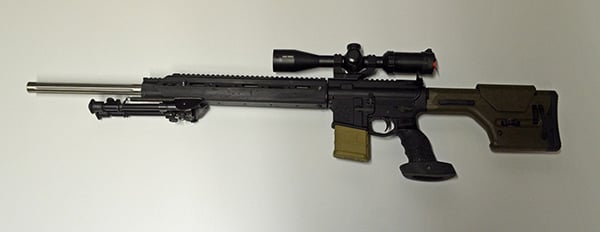
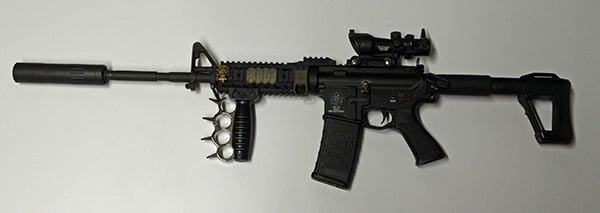
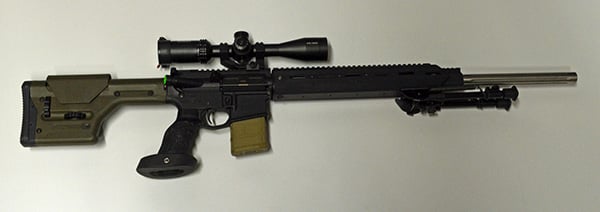

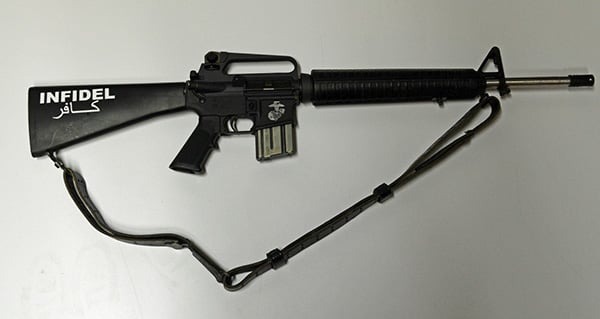



Leave a Reply